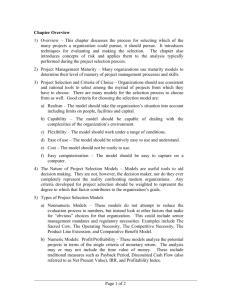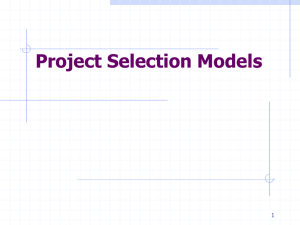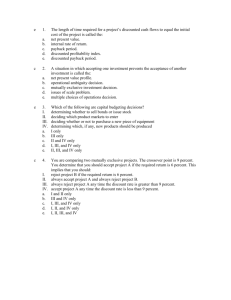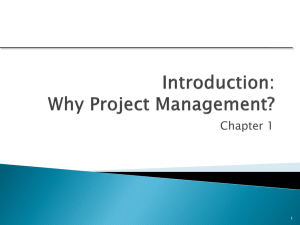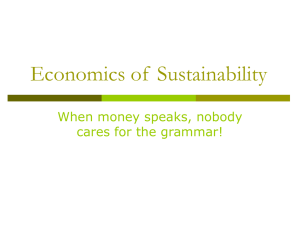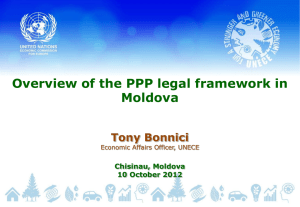Implementing Strategy through Projects
advertisement
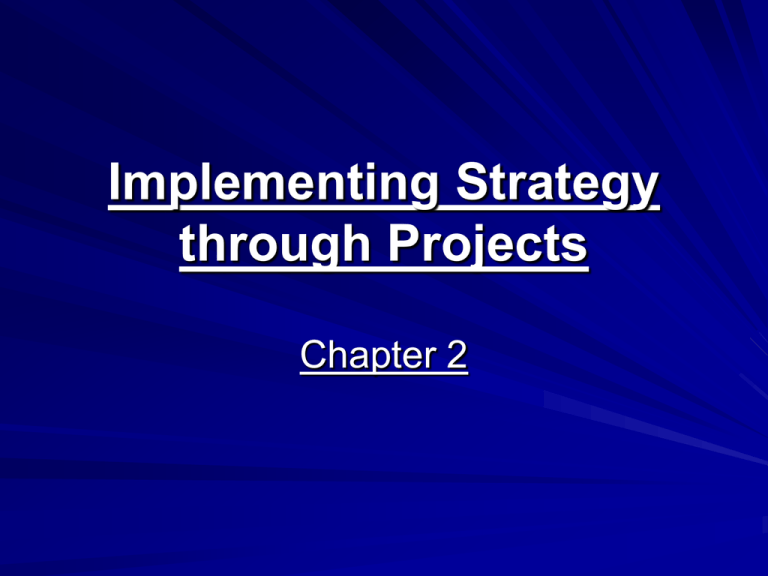
Implementing Strategy through Projects Chapter 2 Project Management Maturity 1. 2. 3. To measure in different ways the organization's project managers mastery of the skills required to mange projects completely is called Project Management Maturity. Capability Maturity model for software development and 4 other industries by Carnegie Mellon university: it consists of a questionnaire of 148 questions divided into 6 processes/ life-cycle phases( initiating, planning, executing, controlling, closing and project-driven organization environment. PMBOK knowledge areas. ( scope, time, cost, quality, human resource, communication, risk and procurement) The model assessing an organization’s project management maturity in terms of essentially the same 5 stages as just described but called : ad-hoc, planned, managed, integrated, and sustained. Project Management Maturity 1. 2. 3. 4. 5. PM3 registered by R.Remy: in this system of management maturity an organization is assessed as being at one of these levels. Ad-hoc: disorganized, accidental success and failures Abbreviated: some processes exist, inconsistent management, unpredictable results Organized : standardized results, more predictable results. Managed : controlled and measured processes, results more in line with plans Adaptative: continuous improvement in processes, success is normal, performance keep improving Project selection and Criteria Choice Project selection is the process of evaluating individuals projects or group of projects, and then choosing to implement some of them so that the objectives of the parents organization will be achieved. Project selection is only one of the decisions associated with project management To deal with all of these problems, we use decision aiding models. Such models abstract the relevant issues about a problem from the plethora of details in which the problem is embedded. Reality is far to complex to deal with in its entity. The process of carving away the unwanted reality from the bones of a problem is called modeling the problem. The idealized version of the problem that results is called the model. The model represents the problem structure and its forms. Every problem has a form, though often we may not understand a problem well enough to describe its structures. Categories for Project Selection model 1. 2. 3. When a firm chooses a project selection model, the following criteria, based on Souder(1973) are most important: Realism: the model should reflect the reality of manager's decision including the multiple objectives of both the firm and its managers. Capability: the model should be capable enough to deal with multiple time periods, simulate various situations both internal and external to the project( e.g. strikes, simulate various interest rate changes) Flexibility: the model should valid results within the range of conditions that the firm might experience. It should have the ability to be easily modified, or to be self-adjusting in response to changes in the firm’s environment. Cont… 4. 5. 6. Ease of use: the model should be convenient, not take a long time to execute, and be easy to use and understand. Cost : data gathering and modeling cost should be relatively low to the cost pf the project and must surely be less than the potential benefits of the project. Easy computation: it should be east and convenient to gather and store the information in the computer database and to manipulate data in the model through use of widely available standard computer package such as Excel, lotus 1-2-3. quarto Pro etc. Types of Project selection Models 1. 2. Nonnumeric Models The sacred cow : the project is sacred in the sense that it will be maintained until successfully concluded, or until the boss personally, recognizes the idea as a failure and terminates it. The Operating Necessity : if a project is required in order to keep the system operating, the primary question becomes: is the system worth saving at the estimated cost of the project ? If the answer is yes, project cost will be examined to make sure they are kept as low as is consistent with project success, but the project will be funded. Types of Project selection Models 3. 4. The Competitive Necessity : although the planning project are quite sophisticated, the decision to undertake the project was based on a desire to maintained the company’s competitive position in that market. Investment in an operating necessity projects takes precedence over the competitive necessity project, both types of projects may bypass the more careful numeric analysis used for projects deemed to be less urgently or less important to the survival of the firm. The product Line Extension : a project to develop and distribute new products would be judged on the degree to which it fits the firm’s existing product line, fills a gap, strengthens a weak link, or extends the line in a new, desirable direction. Decisions makers can act on their beliefs about what will be the likely impact on the total system performance if the new product is added to the line. Types of Project selection Models 5. Comparative Benefit Model : for this situation assume that an organization have many projects to consider, perhaps several dozens. senior management would like to select a subset of the projects that would most benefit the firm, but the projects do not seem to be easily comparable. The concept of comparative benefits , if not a formal model, is widely adopted for selection decision on all sorts of projects. Numeric models: profit/profitability A large majority of firms use projects evaluation and selection models use profitability as the sole measure of acceptability. Payback period: the payback period is the initial investment for the project in the project divided by the estimated annual inflow from the project. Payback period= initial investment / annual net cash inflow Average rate of return: the average rate of return is the ratio of the average annual profit to the initial or average investment in the profit. Average rate of return = the average annual profit/ average investment in the project. Discounted cash flow: also known as NPV. The discounted cash flow method determines the net presenter value of all cash flows by discounting the required rate of return as follows: Cont… Discounted cash flow: also known as NPV. The discounted cash flow method determines the net presenter value of all cash flows by discounting the required rate of return as follows: Analysis Under Uncertainty- The Management of Risk. 1. 2. Risk has been interpreted as being about project tasks during and/or costs, but uncertainty plagues all aspects of the work on projects and is present in all stages of life cycle. So it is important to consider uncertainty as it affects the selection process. Before proceeding forward it is necessary to distinguish between ‘risk’ and ‘ uncertainty’. The outcome of this decision depends on 2 things. What the decision maker does What nature does. Nature being the set of exogenous factors that interact with the decision maker's coarse of action to produce an outcome. If the decision maker knows the profitability of each and every state of nature and thus of each and every outcome, he can find the expected value of each alternative course of action he does. The expected value of an action is the sum of the values of each outcome associated with action times the probability that it will occur. Cont… She can select the course of action associated with best of these expected outcomes. This is decision making under conditions of risk. If the decision maker’s information is not so complete and he does not know and cannot collect sufficient data to determine the probability of occurrence for some states of nature, she cannot find the expected value foe each of his alternative actions. This is decision making under conditions of uncertainty. If the decision maker elects to ignore all states of nature except the one she thinks most likely, she then assumes there is one and only one possible outcome- which is decision making under conditions of certainty. Cont… We try to reduce such uncertainty by the preparation of pro forma documents. Pro forma profit and loss statements and break even charts are example of such documents. Risk analysis is a method on such a procedure. With the great availability of microcomputers and user-friendly software( e.g. crystal ball) , these procedures are becoming very common. Project Portfolio Process The PPP is the attempt to link the organization’s goals directly to the goals and strategies of the organization. this occurs not only in the project’s initiation and planning stage, but also throughout the life cycle of the projects as they are managed and eventually brought to completion. Purpose of PPP If the goals and strategies have been well articulated, however, then the PPP can serve many purposes: 1. 2. 3. 4. 5. 6. 7. 8. 9. 10. To identify projects and non projects. To prioritize the list of available projects Manage important projects Identify projects best fitted for organization’s objectives. Identify projects serving multiple goals and supporting other projects Eliminate projects incurring excessive risk. Or cost Eliminate projects bypassing formal selection process with no benefits corresponding to risk/ Or cost Keep the organization being overloaded by resource available To balance the resource with the needs To balance short, medium and long tern returns. Steps in PPP The steps in this process follows those described in Longman, Sandahl, and spier(1999). Step 1: establish a project council Step 2 : identify project categories and criteria. 1. Derivative projects 2. Platform projects 3. Breakthrough projects. 4. R & D projects. Steps in PPP Step 3 : collect project data Step 3 : Assess Resource availability Step 5: Reduce the project and criteria select. Step 6 : Prioritize the projects within Categories Step 7 : Select the projects to be funded and held in reserve. Step 8 : implement the process.
